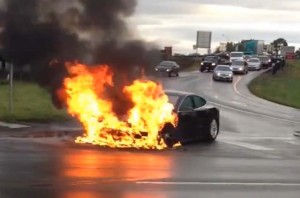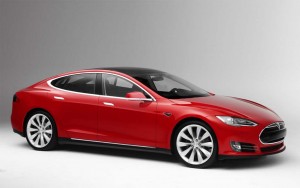By Tesla’s account, the battery-car start-up generated a $16 million profit for the third quarter – but by generally accepted accounting practices, or GAAP, the maker would have plunged $38 million into the red for the July to September period.
And that sent already nervous investors skittering for the exit, Tesla stock quickly plunging by nearly $20, or around 11%, in after-hours trading – continuing the decline that was triggered last month both by two battery fires involving the Model S sedan and by negative analyst reports suggesting Tesla shares have been highly over-rated.
Nonetheless, Tesla shares have remained more than 400% above where they began 2013, even after sliding from a $194.50 peak in September.
In a letter to shareholders, Tesla indicated it expects fourth-quarter earnings to be “about consistent” with the third quarter, a surprise to analysts who had been anticipating an increase as production and sales of the Model S battery-car continue to grow. Musk indicated Tesla is boosting research and development spending by 25% to ensure it can have the maker’s second electric vehicle, the Model X sport-utility vehicle, ready for its late-2014 launch.

Two recent Tesla Model S fires -- including this one in Seattle -- have contributed to the decline of the company's stock price.
As Tesla wrapped up the third quarter almost everything seemed to be going its way. The Model S was in strong demand – as TheDetroitBureau.com recently reported, the battery car becoming one of the best-sellers in the country’s most affluent communities. And its stock hit a record high as investors surged in. But things have gone south since then, with two fires raising concerns about Tesla’s technology – despite personal assurances from Musk – and investors question the long-term value of Tesla shares.
(Tesla tops the auto buying charts in America’s wealthiest neighborhoods. Click Here for the full story.)
Meanwhile, Tesla’s earlier lifeline, which came from selling zero-emission vehicle credits to other makers, has continued to decline. That revenue source helped prop up the maker before the Model S debuted and still generated $51 million during the second quarter of this year. But revenues from ZEV credit sales dipped to just $10 million during the latest period.
That’s not to say the company is falling apart. Far from it. Tesla continues to gain momentum in the market even as lower fuel prices have disconnected a number of other battery-based vehicles. And demand is growing not only in the U.S. but in Germany and other parts of Europe where the maker is currently setting up a new distribution network.
(Second Model S fire raises new concerns. Click Here for the story.)
Production, meanwhile, is also on the rise. According to the maker, it is now producing 550 of the Model S sedans a week and gross margins have also risen from 14% to 21%.
“There is a huge amount of demand in North America,” Musk told analysts during a conference call following the release of Tesla earnings. But, if anything that is causing the maker challenges keeping up, especially as, “we have to start delivering cars to Europe.”
(New battery deal could boost Tesla production. Click Here for the full details.)
The third-quarter numbers triggered yet more concerns about where Tesla stock will settle in. Auto analyst Brian Johnson, of Barclays, issued a cautionary note to clients suggesting that “Results with somewhat slower ramp of Tesla S deliveries reinforce our view that Tesla had overshot in the past few months and is more properly valued at $141.”


I still have not seen those production numbers.
Looks like a steaming pile of BS to me.
I’m waiting to see what happens when their books are audited.